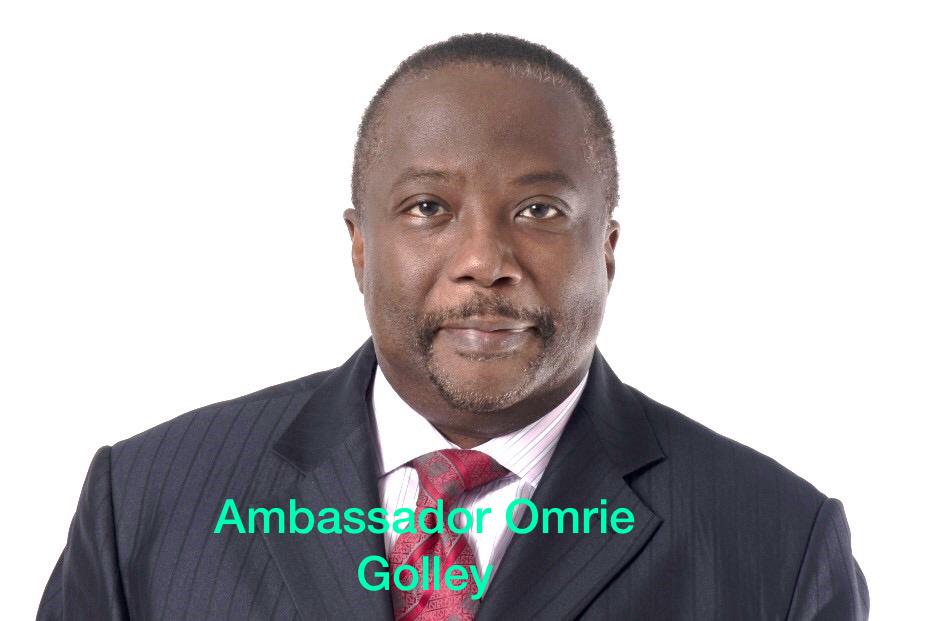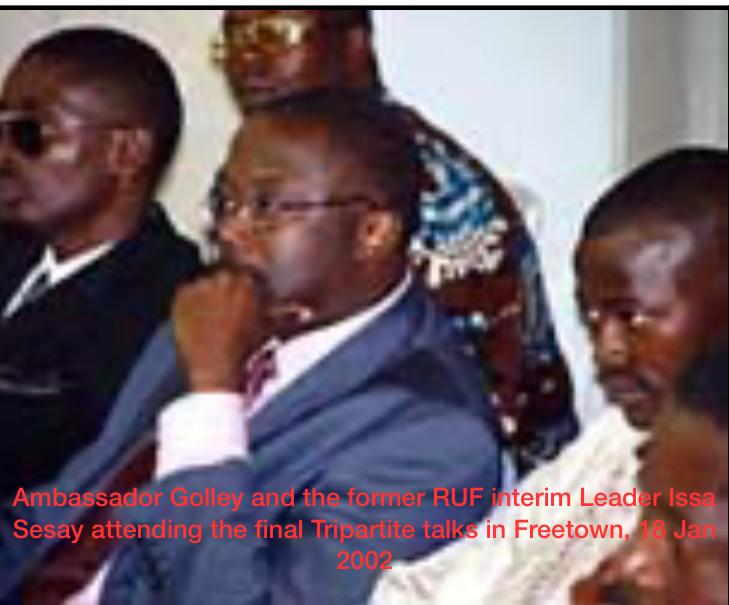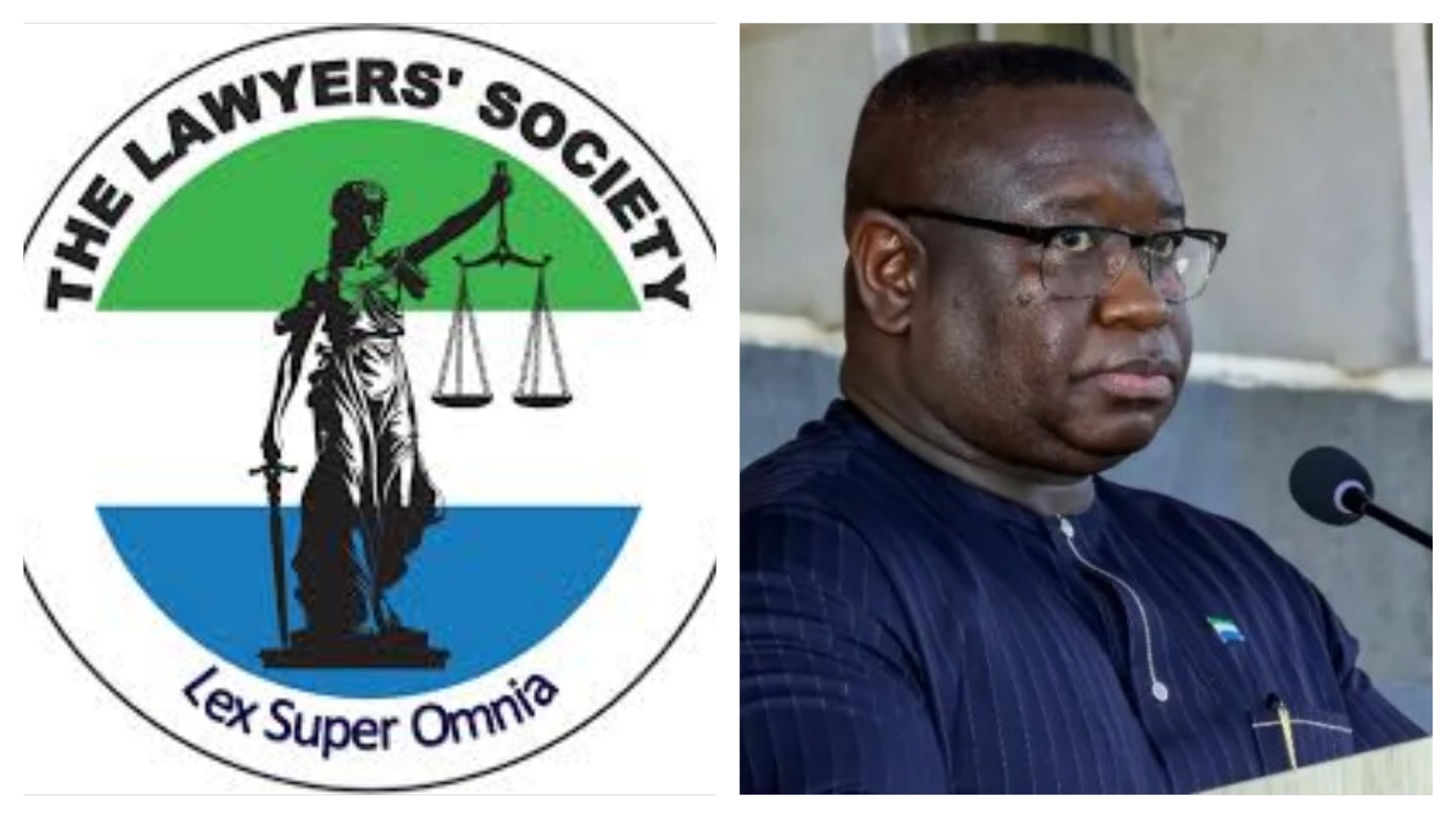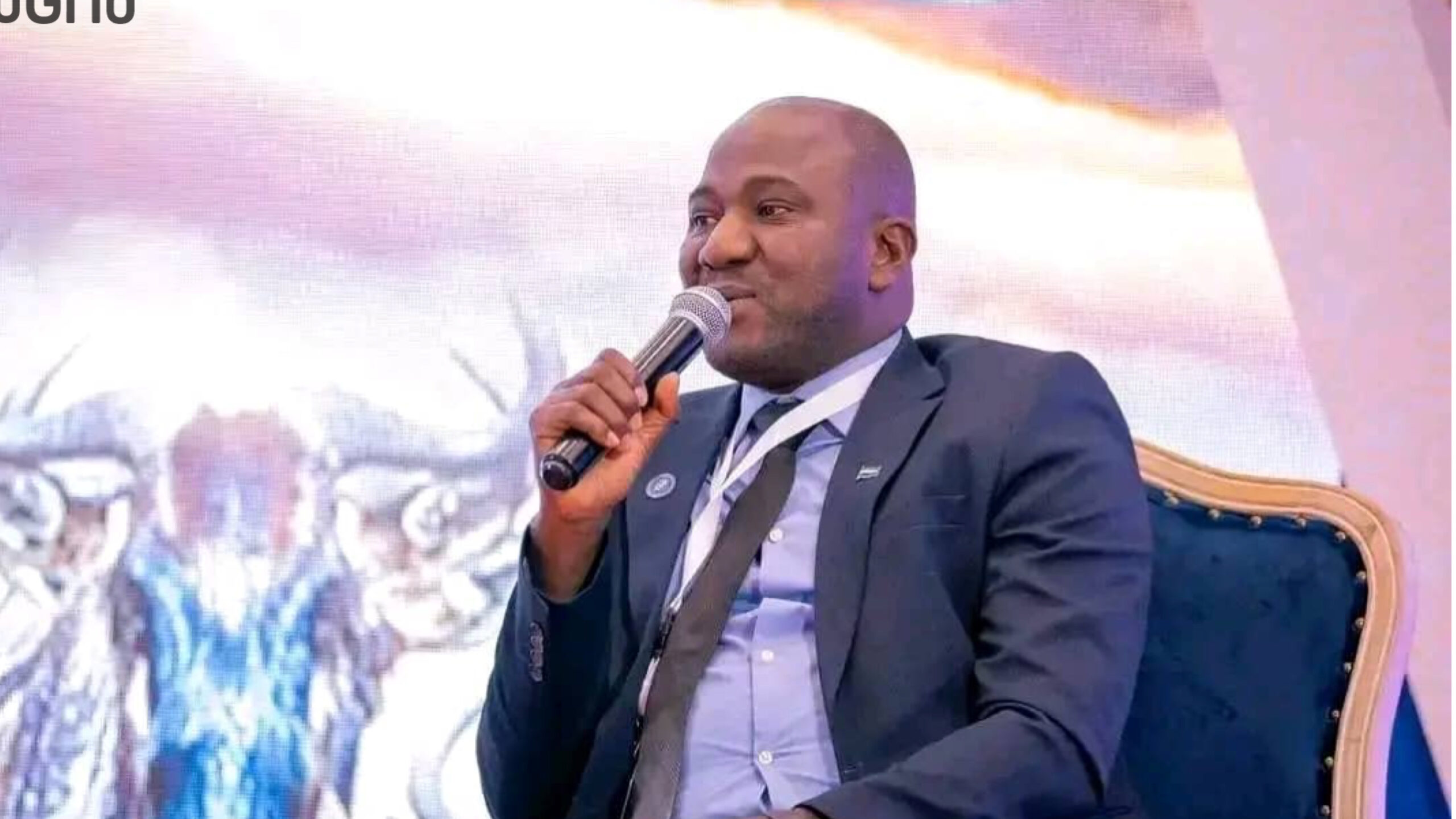
_By Noellie Marionette-Chambertin_
We have now come almost full circle in highlighting the role of Ambassador Omrie Golley in the peace and disarmament process. The Process culminated in the declaration of the ending of the War by former President Kabbah, in January 2002, in his now famous utterance:
‘Di war don don’.
Much had to be done however, during the twelve months preceding Kabbah’s statement referred to above, in getting the two main protagonists, to the conflict, to finally lay down their weapons and pursue peace.
In this difficult task, the role of Ambassador Golley was crucial, and this role was subsequently recognized by the United Nations, ECOWAS, international humanitarian institutions, and the Government of President Tejan Kabbah.
Writing on the ending of the war in Sierra Leone, in the acclaimed British daily newspaper ‘The Independent’ on the 9th February 2002, their investigative journalists Declan Walsh and Robert Verkaik stated, inter alia:
“Diplomats, human rights workers, and government figures agree Mr Golley has played a crucial role in the recent peace process, which has seen the RUF disarm and transform itself into a political party.”
The journalists went on to quote Solomon Berewa, erstwhile Attorney General and Minister of Justice, who had led the Tejan Kabbah Government’s role in the peace process:
“He (Ambassador Omrie Golley ) has been very positive in the achievement of peace.”
Culled from the Independent Newspaper – Saturday 9th February 2002 –
The period following the attack on the residence of the RUF leader Foday Sankoh in May 2000, had brought another breakdown in the peace process, and hostilities between Pro-Government forces and the RUF restarted.
By the end of May 2000, the northern provincial town of Lunsar, in Port Loko District, had been overrun by RUF forces. In addition there were renewed hostilities in different parts of the country. The United Nations (UNAMSIL) had commenced deploying peacekeeping troops around the country, which had assisted in lessening hostilities.
In addition, British military forces invited in by the Kabbah Government, to assist in military operations to gain control of the country, had made significant gains in military offensives against the RUF, allowing for the further deployment of UN peacekeeping operations.
Notwithstanding these military gains, it was clear to the United Nations and other humanitarian agencies involved in tending to the local war affected population, that there was an urgent need for renewed diplomatic efforts to end renewed hostilities in the country.
As David Wilmshurst, Spokesman for UNAMSIL, the United Nations Peace Keeping Organisation, stated, in a news briefing on the 1st June 2000:
“What is important now, is that the fighting does stop so that we could find a way to talk to each other again. There is no military solution to this conflict.”
Culled from Peter Andersen – News Archives of the Sierra Leone Web – 1st June 2000
Ambassador Golley meanwhile had returned from Freetown to London, in October 1999, with the return of the RUF Leader to Sierra Leone from Togo and the Lome Peace talks, and consequent of the fact that Golley had formally resigned from the RUF on the 28th December 1999.
Thereafter, Ambassador Golley maintained watching brief regarding continuing events in his country, but did not take any active role.
He (Golley) was, however, unhappy with the overall situation in the country, particularly with the increase in military hostilities, in the aftermath of the signing of the Lome Peace Accord. He believed however by this time, that he had done all that he could to advance peace in his motherland.

Within the RUF movement, splits had emerged amongst the main military commanders, after the capture of their Leader, on the 17th May 2000, in the aftermath of the ‘May 8th incident’.
In addition, the imprisonment of Foday Sankoh, had occasioned the need for the Movement, to choose a new Leader to attempt to unify the RUF into a cohesive structure. With the active support of ECOWAS and sub-regional leaders, Issa Hassan Sesay, was chosen as the new RUF interim leader, to unify the movement and to assume the leadership in any subsequent peace talks.
The Lome Peace Accord, entered into in July 1999, between the Sierra Leone Government and the RUF, had agreed on the Disarmament, Demobilization and Rehabilitation (DDR) of all combatants that had been involved in the conflict, as a central plinth of the Agreement. At that point, it was clear and paramount to all observers, that if DDR was to be successful, the RUF, had to be properly structured, under a unified leadership for its (DDR) success.
However splits in the RUF in the aftermath of the detention of their Leader, made it very difficult to achieve the successful disarmament of their ex-combatants.
In addition, prior to the disarmament of Government controlled militias and the RUF, a new ceasefire agreement in Abuja, in November 2000, between the warring factions, had to be reactivated. Humanitarian access to the war weary population, and skirmishes between the opposing forces, made the desired goal of disarmament, difficult to achieve.
It soon became clear, that unless the difficulties identified above were adequately addressed, it would in turn be very difficult to proceed with a process, leading to the disarming of all ex-combatants involved in the war, and their ultimate reintegration into the towns and villages from which they came.
It was this realisation, that informed the United Nations, through their Special Representative of the erstwhile Secretary General- Nigerian born Ambassador Oluyemi Adeniji to contact Ambassador Golley in London in January 2001, to return to Freetown, yet again, to assist in the revitalization of the peace process, that, at this period, was in danger of disintegrating.
Whilst Ambassador Omrie Golley was most reluctant to return to the maelstrom of peace process issues, he was persuaded to return to Freetown in February 2001, after assurances from the Special Representative of the United Nations Secretary-General, Ambassador Oluyemi Adeniji, that his personal safety and security, would be adequately safeguarded.
Ambassador Golley also sought and received written assurances about his security from the Government of President Kabbah through their erstwhile Attorney General and Minister of Justice, Solomon Berewa.
Prior to returning to Freetown in February 2001, Golley travelled to Monrovia Liberia to meet with the newly appointed Interim Leader of the RUF, General Issa Hassan Sesay, who prevailed upon Ambassador Golley, to head a soon as possible to be formed RUF Political and Peace Council, to oversee the peace process and proceed to the disarmament of all ex-combatants involved in the conflict.
With the acceptance of this latest position within the RUF, to support the commencement of a fresh peace initiative, Ambassador Omrie Golley entered the most difficult part of the renewed peace process, which was to agree a new ceasefire with the government controlled militia otherwise known as the Civil Defence Forces ( CDF), headed by erstwhile Deputy Defence Minister, the late Sam Hinga Norman, and the RUF, and to commence disarmament of all fighting groups involved in the conflict.
On the 1st May 2001, Ambassador Omrie Golley led a six man delegation, comprising senior military officials of the RUF, to Abuja to meet with officials of the Sierra Leone Government, headed by then Attorney General and Minister of Justice, Solomon Berewa, and the leadership of the Government controlled CDF Militia.
This meeting, to review the previously agreed Abuja Peace Accord of November 2000, referred to above, and to map out the next stages of the peace process, involving disarmament, was also attended by officials of the United Nations, ECOWAS, and the Sierra Leone Government, with the erstwhile Organisation of African Unity (OAU) acting as Observers.

The meeting between the RUF, the Sierra Leone Government, together with those of the CDF went well, and agreement to restart the peace process, by ceasing all hostilities, was swift. The meeting afforded Ambassador Golley the opportunity, in particular, of meeting and conferring with the late Leader of the CDF, and erstwhile Deputy Minister, Sam Hinga Norman.
Ambassador Golley remembers their encounters:
“During this period in Abuja, I got to meet with the Minister on several occasions, both formally and informally. I became convinced at an early stage in our deliberations, that he was sincere in his desire to restart the peace process, and end the conflict.”
Agreement between both sides was reached within 24 hours of the commencement of the Meeting, on the 2nd May 2001.
Unlike many other Agreements entered into for the duration of the conflict, this Agreement on the cessation of hostilities, signed by the CDF leader, and Ambassador Omrie Golley, as Chairman of the newly created RUF Political and Peace Council, and ratified in Freetown on the 15th May 2001, withstood the test of time, and in effect, signaled the end of the 10 year old conflict.
The recently signed and ratified Abuja Declaration of May 2001, was in effect, a re-affirmation of the recently failed Abuja Peace Accord of 2000, and called for the cessation of hostilities, the disarmament, demobilisation and re-integration, of all former combatants of both the RUF, and CDF, and the transformation of the RUF into a political party.
Both the Government and RUF Delegations, returned to Freetown from Abuja after concluding their meeting, together, as one Delegation, to underscore its success.
That symbolic move, was actively encouraged by the personal intervention of the erstwhile President of the Federal Republic of Nigeria, Olusegun Obasango, who graciously provided the Delegations, with the Nigerian Presidential Aircraft, to transport both delegations back to Freetown.
Upon the return of both the Government and RUF Delegations to Freetown, the complex and difficult part of the Agreement, commenced with the disarmament of the former fighting groups, under an implementation plan.
This implementation plan, took the form of a number of tri-partite meetings, held in different parts of Sierra Leone, between the Government and the RUF, with the United Nations, acting as the Chair to both delegations during these talks.
In fact there were 7 meetings that took place from May 2001 to November 2001, between the Government of Sierra Leone and the RUF, chaired by the United Nations, through their Special Representative of the Secretary General, Ambassador Oluyemi Adeniji. The erstwhile Attorney General and Minister of Justice, Solomon Berewa, headed the Government of Sierra Leone Delegation for the duration of these meetings, and Ambassador Omrie Golley, headed the RUF Delegation.
As Golley remembers:
“In fact this stage of the peace process, (ie the disarmament programme ), was, arguably, the most arduous and difficult. I had to visit various parts of the country where RUF ex-combatants were stationed, accompanied by UN peacekeepers, actively encouraging them to give up their weapons.
That was an extremely difficult task. The ex-combatants were, on the whole, very skeptical of the whole peace process, and giving up their weapons, which some of them had held, for nearly ten years previously, was very hard for them to bear ‘.
Ambassador Omrie Golley traversed the length and breadth of his motherland, visiting RUF bases, together with those of the former Government controlled Civil Militia, the CDF, always accompanied by UN Peacekeeping troops, actively encouraging the disarmament, demobilisation and re integration, of the former fighting groups.

Ambassador Omrie Golley spent lengthy periods of time, living with the former combatants of the RUF, at their various locations, to gain their trust, often having to listen to their experiences of fighting a 10 year war. Some of these experiences, often recounted with glee and mirth, by some of these former fighters, were, for Ambassador Golley, often gruesome and unpleasant, to have to listen to.
Ambassador Golley also found himself during this period, frequently adjudicating and settling quarrels, and long standing disputes and rivalries amongst the former commanders of the Movement. Sometimes these occurrences were very serious, with the potential for disrupting the whole disarmament process, looming large.
The process of disarmament was carried out successfully in the 8 months from May 2001 to January 2002. On the 17th January 2002, representatives of the Government of Sierra Leone and the RUF, met in Freetown for the last time, with both sides formally declaring the end of the disarmament process, with the disarming of 46,453 former fighters.
The 10 year old conflict was truly at an end.
On the 18th of January 2002, President Kabbah, at a symbolic burning of firearms previously held by the former fighting groups, formally declared the war to be at an end, with his now famous quote :
‘Di war don don’
Ambassador Omrie Golley, in a statement issued on the 19th January 2002, to commemorate the ending of the war, had this to say:
“I consider the end of disarmament and the end of the war, to be the first stage of the consolidation of the peace process, but there is a lot more work to be done, particularly in terms of tackling the problems in our society,- that of poverty, corruption, nepotism, and economic and social mismanagement.”
Culled from Peter Andersen – Sierra Leone News – January 2002 – The Sierra Leone Web
Very strong, meaningful, insightful words coming from Ambassador Omrie Golley, in January 2002, 19 years ago.
*Note*
For further enquiries on our episodes, please contact the writer:
Noellie Marionette-Chambertin
Phone number: +447535506716
Email: noelliechambertin@mail.com



